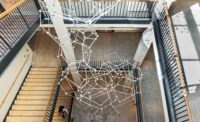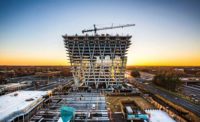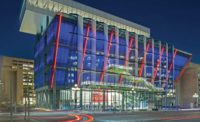An elementary school with a 500-gallon saltwater fish tank modified from a Hurricane Sandy-salvaged bus is just one example of the creativity displayed in the winning entries in this year’s ENR MidAtlantic Best Projects competition. As impressive as the William F. Cook Jr. Elementary School’s aquarium is, the Hockessin, Del., project got a run for its money in the K-12 education category from the Lab School of Washington. The innovative experiential facility at a school for students with learning disabilities was one of the first projects in the country to use a robot that lays brick four times faster than a human can, project officials say.
Those two projects are joined by the winners in 16 other categories. They were chosen by a panel of eight professionals from across the industry—including architects, engineers, contractors and a public owner. Judges were divided into two groups and each was assigned a number of categories. A separate jury of three safety specialists picked the Safety Award of Excellence.
The winners were evaluated according to a set of criteria: the project team’s ability to overcome challenges; the project’s contribution to the industry and community; safety; and construction and design quality. The honorees were chosen from 65 projects from throughout the region, which includes Delaware, Maryland, Pennsylvania, Virginia, West Virginia and the District of Columbia. The projects had to be completed between May 1, 2015, and June 30, 2016.
Judges had the option of selecting any combination of Best Project-level category winners and award of merit honorees. They also named an overall Project of the Year: the Blue Plains Tunnel in the District of Columbia. The 24,200-ft long, 26-ft-dia combined sewer overflow tunnel was constructed in soft ground 100 ft below and adjacent to the Potomac and Anacostia rivers. The tunnel aims to reduce sewer overflows into the Anacostia River by 98%.
Higher education/research and renovation/restoration also was a hotly contested category. The judges gave a slight edge to the Virginia Commonwealth University’s Cabell Library over the University of the District of Columbia’s New Student Center. The renovated and expanded Cabell Library includes a space for do-it-yourself projects, flexible workspace, media studios and a 300-seat theater. UDC’s 80,000-sq-ft New Student Center, built on a tight urban site, was the first student union in the nation to achieve LEED Platinum certification.
- Project of the Year, MidAtlantic - Blue Plains Tunnel
- Cultural/Worship Best Project - Congregation Rodeph Shalom
- Excellence in Safety Award and Energy/Industrial - Brunswick County Power Station
- Health Care Award of Merit - Inova Women's Hospital and Inova Children's Hospital
- Health Care Best Project - The Children's Hosptial of Philadelphia Buerger Center for Advanced Pediatric Care
- Highway/Bridge Award of Merit - Hulton Bridge
- Highway/Bridge Best Project - Bay Bridge
- Interior Award of Merit - WeWork/WeLive
- Interior Design Best Project - Nixon Peabody
- K-12 Education Award of Merit - The Lab School of Washington New High School Addition
- K-12 Education Best Project - William F. Cooke, Jr. Elementary School
- Landscape/Hardscape Best Project - Flight 93 Memorial Plaza and Visitor Center
- Manufacturing Best Project - Stone Brewing-Richmond
- Residential/Hospitality Award of Merit - Atlantic Plumbing Parcels A&B
- Residential/Hospitality Best Project - Quirk Hotel
- Small Project Best Project - Baltimore Visitor Center Renovation
- Government/Public Building Best Project - Arthur Capper Community Center
- Higher Education/Research Award of Merit - UDC New Student Center
- Higher Education/Research Best Project - VCU Cabell Library
- Office/Retail/Mixed-Use Award of Merit - 601 Massachussetts Avenue
- Office/Retail/Mixed-Use Award of Merit - Gateway Plaza
- Office/Retail/Mixed-Use Best Project - The Tower at PNC Plaza
- Renovation/Restoration Award of Merit - Roosevelt High School Modernization
- Renovation/Restoration Award of Merit - United Arab Emirates Chancery
- Renovation/Restoration Best Project - 5600 Fishers Lane
- Specialty Construction Best Project - Deck Rehab and Joint Modifications to Bridge on 1-95
- Sports/Entertainment Award of Merit - Virginia Tech Indoor Athletic Training Facility
- Award of Merit Excellence in Safety Award
- Sports/Entertainment Best Project - VCU Basketball Development Center






Post a comment to this article
Report Abusive Comment